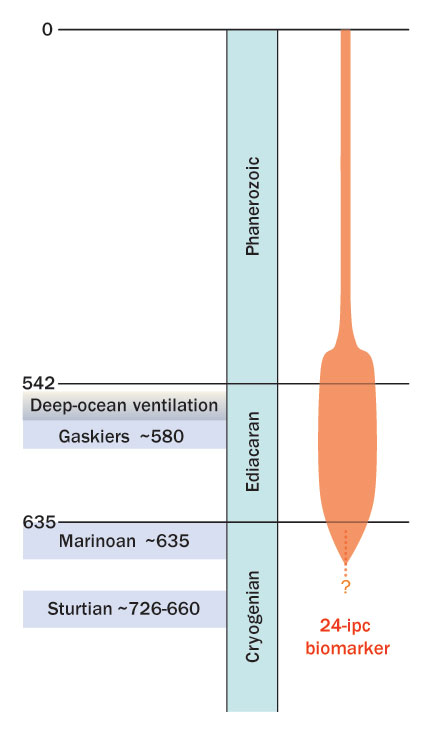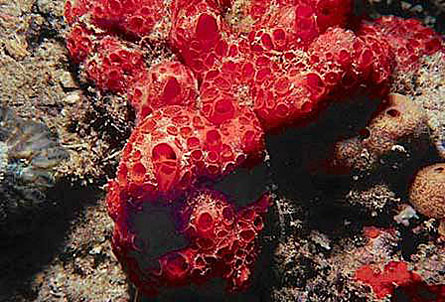- More than 2 years ago
A new analysis of ancient chemical fossils has rocked the cradle of early animal evolution, bumping back compelling evidence of animal life to at least 635 million years ago.


The findings, published in the Feb. 5 Nature, suggest that the ancient ancestor of fully formed animals survived a massive glaciation that enshrouded the Earth in ice at the end of the aptly named Cryogenian period. Debate continues over how much of the planet was frozen during two ice ages, each possibly a “snowball Earth” event that flanked this period, which extended from about 790 million to 630 million years ago.
The new results suggest that even if glaciers reached the equator during the second ice age, it is likely that warm pockets, perhaps created by volcanic activity or hydrothermal vents, may have persisted and harbored life.
“Evidence of animal life from before the Marinoan,” the severe glaciation of 635 million years ago, “is really something,” says Jochen Brocks of the Australian National University in Canberra. Brocks and Nicholas Butterfield of the University of Cambridge in England coauthored a Nature commentary on the new work.
There’s evidence of eukaryotic life — organisms with DNA sequestered in a protective nucleus — from roughly 1.9 billion years ago, says Brocks. But proper multicellular animals don’t appear on the scene until much later. The Cambrian explosion is often cited as the inaugural ball of animal evolution, a period of roughly 20 million years that began about 520 million years ago when representatives of many of today’s major animal groups became established.
But there’s a fair amount of evidence that animals evolved before the Cambrian, including a bizarre assemblage known as the Ediacaran fauna, which flourished during the Ediacaran period that some studies suggest lasted from about 635 million to 542 million years ago. Many scientists believe the multicellular animals of Ediacaran were an early experiment in animal evolution that ended badly and had few survivors.
Sponges, however, may have come on the scene before the Ediacaran period and lived through it. The new analysis, led by organic geochemist Gordon Love of the University of California, Riverside, documents the molecular remains of a steroid from sedimentary rock deposited 150 meters below the end of the Marinoan ice age. (Researchers debate when this ice age actually started.)
The steroid fossil, known as 24-isopropylcholestane, or 24-ipc, is the geologically stable form of a steroid known today from the cellular membranes of one of the three classes of sponges, the Demospongiae. A small group of algae also make the molecule, but the ratios of 24-ipc to other algal compounds rules algae out as a source.
Working with cores from a salt basin in south Oman, Love and his team document the presence of 24-ipc throughout the Ediacaran and in the layers beneath. To ensure that this chemical fingerprint hadn’t migrated from younger rocks, the researchers also analyzed the signal from the tough matrix of organic matter known as kerogen that can’t move through rock.
The findings can’t say when multicellular animals first appeared but can say that multicellular animals had to be around by at least 635 million years ago and, the researchers report, maybe as early as 751 million years ago.
“These are the oldest bona fide animal fossils,“ says molecular paleobiologist Kevin Peterson of Dartmouth College. Putative fossil embryos that date to around 580 million years ago were previously the oldest unequivocal fossils considered ancestors of today’s animals.
“Finding a molecule that was made by an organism, that means the biosynthetic ability to make that molecule must have evolved earlier,” Brocks says.
The Cryogenian period is marked by an early glaciation — the Sturtian — then a period of warming, and then a second glaciation, the Marinoan. The fossil molecules suggest that the animals that made them had to be around by the end of the Marinoan, and they may have evolved in the warming period between the Sturtian and Marinoan, Love says.
Even if the glaciations during this snowball Earth period didn’t freeze the seas, as some have suggested, they would have forever altered ocean chemistry, says Love. The environmental upheaval could have opened new niches and presented an opportunity for multicellular sponges to spread throughout the seas.
The new work fits nicely with molecular clock work dating the evolution of multicellular life, says Peterson. It also ties in well with ideas about ocean and atmospheric chemistry. These early sponges might have helped bring about the oxygenation of the deep oceans, which then paved the way for more life. Sponges are a dominant stationary animal in the Cambrian, but then their presence seems to taper off, perhaps because of the rise of other animals.
“Sponges are essentially vacuum cleaners; they suck the organic matter out of the world’s oceans,” Peterson says. Amounts of organic matter, the organic form of carbon, are linked to a complex cycle that includes oxygen.
Brock agrees. “Sponges might have filtered all the crap away, might have been the cleaner of the oceans,” he says. “It’s an interesting idea. In total this is a very nice finding, rigorous work and a good job.”






